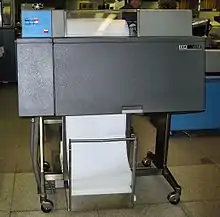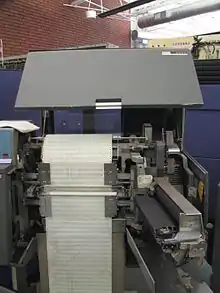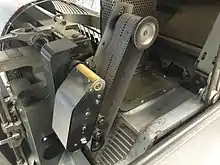IBM 1403
The IBM 1403 line printer was introduced as part of the IBM 1401 computer in 1959 and had an especially long life in the IBM product line. The original model could print 600 lines of text per minute and could skip blank lines at up to 75 inches per second (190 cm/s), while the model 3 could print at up to 1400 lines per minute. The standard model had 120 print positions. An additional 12 positions were available as an option. A print chain with up to 15 copies of the character set spun horizontally in front of the ribbon and paper. Hammers struck the paper from behind at exactly the right moment to print a character as it went by. In later models, the print chain was replaced by a print train; print slugs instead of being mounted on a chain were placed in a track.


The 1403 chain or train contained 240 characters, however numerous duplications allowed a line to be printed in less than the 0.4 s required for one full rotation. The original standard "A" chain contained 48 different characters, repeated five times each. A "preferred character set" variant used in later models printed the same 48 characters, but varied the number of appearances: 10 digits appeared eight times each, 26 upper-case letters appeared four times each, and 12 special characters . , - * % $ / & # @ ⌑ ⧧[note 1] appeared eight (first four), four (middle four) or two (last four characters) times each.[1]:25
Special chains or trains could be ordered for other character sets. Scientific users, for example, would use a chain that had the left parenthesis, the right parenthesis, and the plus sign in place of the per cent sign (%), the lozenge (⌑),[note 2] and the ampersand (&). The numerics chain had 15 copies each of only 16 characters. The "T" chain for general text had two copies of 120 characters, including upper-and lower-case letters and numerous special symbols.
The ink ribbon was a long roll the width of the print area that was positioned between the print chain and the paper. The roll came in two parts, the feeder roll and take-up roll. The roll was constantly wound and rewound during printing.

Like most IBM printers of the era, the 1403 used fan-folded paper with perforated edges for tractor feeding. A carriage control tape or, later, a buffer, under program control,[note 3] specified form length and the form line where printing was to begin so that paper of various sizes could be used.
An IBM 1403 printer played a cameo role in Stanley Kubrick's 1964 movie Dr. Strangelove, serving as a hiding place for a portable radio.
The overstrike capability of the printer was used to generate a wide range of grey-scale equivalents. Many images were scanned, pixelated and could be reproduced on the 1403, most notably the Mona Lisa.[2][3]
These were noisy machines, especially when the cover was raised. Some people were able to create text that used the timing of the print hammers to generate desired frequencies and actually play music when that text was printed.[4]
History
Prior to the introduction of the model 1403, IBM printers utilized technology originally developed for their line of accounting machines. Models 402 and 405 used type bars.[5] These were vertical bars, one for each print position. Each bar was one character wide with either the entire alphabet, including numerals and symbols, or just numerals & symbols only, molded into the front surface, in a single column. In printing, each bar was raised up until the correct character for that print position was opposite the paper, whereupon the bar was pushed toward the paper, so that the correct numeral or letter pressed against the ribbon, striking the paper much the way type slugs leave an impression on paper in a standard typewriter. This action was relatively slow, as it took time for each bar to be brought up into the correct position and then drop back down in preparation to print the next line.
In the model 407, each type bar was replaced with a type wheel, with the characters along the outside edge. To print, each wheel was rotated to the correct character position, then the entire wheel was pushed forward to strike the paper. This action was somewhat faster in that the wheels were less massive than the bars and could be positioned more rapidly. Still, however, speeds of 150 lines per minute were all that were achieved. Although this might seem slow by later printing standards, the speed at which electromechanical accounting machines could read punched cards and perform their basic arithmetic functions meant that no faster printing speeds were needed. The IBM 1132 was the last printer manufactured by IBM to use this technology.

When faster computers were developed, however, the speed of card reading, magnetic tape, and early disk drives, along with newer high speed transistorized circuits, meant that processing could be done at a much higher speed, and a faster print mechanism was needed to match the resulting productivity.[6] IBM's early computers, such as the IBM 701, were developed for higher speed calculation than was possible with earlier electromechanical calculating machines. They did not have a demand for high speed printing, as the results of massive calculations produced very little printed output. Around the time that the 1403 was introduced, IBM's line of computers had been largely divided into two lines, "scientific" and "business." However, as newer computers were being used for a greater variety of purposes, there was a need to print a greater variety of characters from a single device, including upper and lower case alphabets. With type bars and type wheels, changing character sets was impractical. The advent of the chain printer, as used in the 1403, allowed the type chain assembly to be removed and replaced within a few minutes. With the cover open, the print unit was unlatched and swung open, the ribbon roll covering the front of the chain was removed, whereupon the print chain assembly could be unlatched and lifted out.
When it was first introduced, 1401 computer system, of which the printer was a part, leased for $6500 per month (equivalent to $54,000 in 2017) and IBM received 3000 orders in the first month.[7]
Technology
Chain printing allowed a single set of characters to pass horizontally across the front of paper at high speed, with a ribbon the full width of the paper passing vertically in between the chain and the front of the paper. Instead of pressing the characters toward the paper, individual type hammers behind the paper, one for each column on the page (120 or 132), pushed the paper from behind, causing the front of the paper at that spot to push forward into the ribbon with the character behind it, causing the paper to strike the character, rather than the other way around, as had been done in the past. Each hammer was moved by a powerful electromagnet, with its coil connected to a high current drive circuit, such that the hammer could be forced out to hit the paper within only a few milliseconds, at exactly the right time to strike the correct character on the chain as it came by.
The columns on the paper were spaced at the standard typewriter pitch of 10 characters per inch, 0.1″ per column. The characters on the chain were spaced 0.1505″ apart, so that for each 0.001″ movement of the chain, a new character aligned with a print column. Moving at 7.5 feet per second, one hammer might fire each 11.1 μs, but they were never exactly simultaneous.[8]
Models
The IBM 1403 had the following models:
- Model 1: 100 print positions, maximum of 600 lines per minute, or 1285 with the Numerical Print Special Feature.
- Model 2: 132 print positions, maximum of 600 lines per minute, or 1285 with the Numerical Print Special Feature, or 750 with Universal Character Set.
- Model 3: 132 print positions, maximum of 1100 lines per minute, or 1400 with the Preferred or Universal Character Sets.
- Model 4: 100 print positions, maximum of 465 lines per minute.
- Model 5: 132 print positions, maximum of 465 lines per minute.
- Model 6: 120 print positions, maximum of 340 lines per minute, single-carriage.
- Model 7: 120 print positions, maximum of 600 lines per minute, single-carriage.
- Model N1: 132 print positions, maximum of 1100 lines per minute, or 1400 with Universal Character Set. The model N1 had a power driven cover that went to the floor to cut noise.
Only models 2, 3, 7 and N1 could be attached to the IBM System/360 and its successors. Attachment was generally by means of the IBM 2821 Control Unit, but some 360 models included an integrated control unit for direct 1403 connection.
Only the Model 6 (340 LPM) or the Model 7 (600 LPM) could be attached to an IBM 1130.[9]
Notes
- That last character, "record mark", is depicted as two horizontal lines crossed with one vertical line, like two vertically offset, overapping + signs, or like a differently proportioned "double dagger" symbol ‡. The most accurate representation is U+29E7 ⧧ THERMODYNAMIC, but that is missing from many fonts.
- The "lozenge" is the square lozenge (U+2311) that resembles an overstuffed pillow, not the diamond-shaped one. Some Unicode typefaces do not render it correctly at this low resolution.
- this was system dependent
References
- IBM 1403 Printer Component Description (PDF). IBM. October 1972. GA24-3073-8.
- Macleod, I.D.G. (February 1970). "Pictorial Output with a Line Printer". IEEE Transactions on Computers. C-19 (2): 160–2. doi:10.1109/T-C.1970.222883.
- Perry, Benson; Mendelsohn, Mortimer L. (May 1964). "Picture Generation with a Standard Line Printer". Communications of the ACM. 7 (5): 311–3. doi:10.1145/364099.364336.
- 1403-generated music at the Computer History Museum
- "The IBM 402 Series of Accounting Machines".
- Bashe, Charles J.; Johnson, Lyle R.; Pugh, Emerson W.; Palmer, John H.; Aspray, Jr., William (1985). Aspray, Jr., William (ed.). IBM's Early Computers. MIT Press. pp. 471–2. ISBN 978-0-262-52393-6.
- Ackerman, Evan (31 March 2017). "How the IBM 1403 Printer Hammered Out 1,100 Lines Per Minute". IEEE Spectrum. Retrieved 31 March 2017.
- Shirriff, Ken (June 2015). "Animation of the print chain on the IBM 1403 printer". The IBM 1401 Demo Lab and Restoration Project. Computer History Museum. Retrieved 2017-04-05.
- "Systems Reference Library IBM 1130 Operating Procedures" (PDF). BitSavers.
External links
| Wikimedia Commons has media related to IBM 1403. |
- "The IBM 1403 at Columbia University".
- "IBM 1403 Font Sample". Computer History Museum.
- "The IBM 1403, and why printers standardized on 132 columns".
 Side view of 1403 with cover open, showing carriage control tape
Side view of 1403 with cover open, showing carriage control tape Carriage control tape loop used to control rapid motion to a particular line in a page, such as top of new page
Carriage control tape loop used to control rapid motion to a particular line in a page, such as top of new page closeup of carriage control tape
closeup of carriage control tape Portion of 1403 print chain
Portion of 1403 print chain SMS card used to drive 1403 print hammers
SMS card used to drive 1403 print hammers